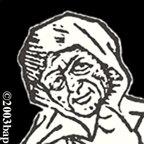Ten Theories about the Origins of the Witch Hunts
Like the Holocaust/Shoah/Final Solution (the attempted extermination of Jews and others by the Nazis in the mid-20th Century), the Witch Hunts demand some sort of explanation.
The "theories" for the causes of the Witch Hunts listed below are drawn from what various historians have suggested. They are called theories, because they are based on reasonable information (or were, when they were first proposed), and make some sense in explaining the phenomena. Each theory below describes the main idea briefly, and after "BUT" lists some of the problems in applying the theory to witch hunts.
None is perfect, some are better than others, and a few are now supported by
only few historians. Some better explain certain hunts in specific places during
limited periods. No one explanation or theory will suffice to explain all Witch Hunts in Europe from 1400 to 1800. To understand the Witch Hunts in their totality, we must keep all
of the theories in mind, and even look for more still. Multiple causation is merely common sense. Any historian who tries to apply one cause to the hunts, or even perhaps to just one hunt, is being too simplistic.
1. Illness Theories: These are variously related to physical and mental conditions of people involved in the hunts. According to a
Mass Hysteria Theory, peasants went a little wacky, becoming clinically neurotic and even psychotic, and in a group panic went after the witches. According to a
Delusion Theory, credence given to childrens fantasies and psychosomatic illnesses are some sources for the panic. Further, a
Disease Theory suggests syphilis or ergotism (caused by mold on rotten bread) as causes for mental instability. Similarly,
Drug Theory suggests that the effects of consuming bad mushrooms, herbs like deadly nightshade or henbane, or bufotenine from the skin of some toads could have affected peoples minds.
BUT, it is hard to explain how so many people, even in one area, could become seriously
ill or disturbed all at once. Additionally, an important characteristic of the witch hunts were their systematic organization by ruling elites and government officials, not some chaotic outbreak.
![]()
BUT these explanations are contradicted by counter examples (regions where the lowlands first hunted and then spread to the hills), or the difficulty of quantifying economic differences.
![]()
BUT many persecuted people did not have much wealth. And, in many hunts property was not confiscated, even from very wealthy targets.
![]()
A. First, the Satanic Religious Rebellion Theory: devil worship actually existed, in particular as a subversive attack on the ruling Christian order. Early historians of witchcraft, such as Jules Michelet (1862) or Montague Summers, take the tortured confessions of witches at their word.
BUT no credible evidence supports the existence of any actual Satanic cults before the 19th century. See Myth #8.
B. Second, the Pagan Religious Rebellion Theory: Certain forms of worship from the ancient world continued through the Early Modern period and was misinterpreted by the Christian hunters as Satanic. This theory was formulated by the Folklorist Margaret Murray (The Witch-cult in Western Europe (1921), The European Witch Cult (1926), The God of the Witches (1960)), who said worship of the horned god Janus or "Dianus" was focus of pagan continuity into modern times. It could be called the Murrayite Theory, and it remains popular in Neo-pagan circles.
BUT no credible evidence reveals the survival of much paganism or any organized fertility cults, beyond common superstition and simple folk traditions. Professional scholars have largely discredited Murrays work. See Myth #8 and Myth #10.
![]()
BUT adherents of one branch of Christianity only rarely used the accusation of witchcraft specifically to persecute someone of another branch. Usually the Witch Hunts were carried out by people of the same type of Christianity as the victims. See also Myth #2.
![]()
BUT many persecutions were done during times of relative peace and plenty. Further, many such troubles were not new to early modern Europe, but have been endemic throughout history. Thus, why were "witches" to blame, and not other common scapegoats (Jews, Sodomites, deviants, foreigners) or other supernatural forces (such as demons without the aid of human witches)?
![]()
BUT how could a rather minor idea, with so little supporting evidence, lead to such enormous efforts by so many people, especially those with little to gain?
![]()
BUT why should witchcraft be the specific target in these years? And why should the hunts be so vicious, and as a result cause such disturbances in the state? And the theory gives too much credit to the elites over the "ignorant" masses.
![]()
BUT these theories do not take into account motives of individual accusations (such as local feuds and grudges), and contemporary explanations of those involved (the religious and political context). And why should the hunts be so vicious? And again, why should witchcraft be the specific target in these years?
![]()
BUT, such theories exaggerate the proportions of women involved and the extent to which women were the focus. See Myth #4. Men in some witch hunts were the majority of victims; and some hunts persecuted children of both sexes.
![]()
| Ten Theories about the Causes of the Witch Hunts | Ten Common Errors and Myths about the Witch Hunts | Timeline |
| tba> | Sources for Salem Witch Hunt | tba |
| Primary Source: Letters from the Witch Trial of Rebecca Lemp: a family deals with accusations. |
Torture: a review of torture in the witch hunts and today. |
Suffer your own persecution! Try a witch hunt simulation: make choices to survive or not. |

 Buy the Book!
Buy the Book!

